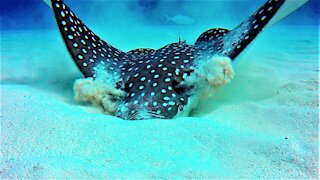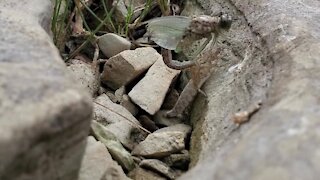Stingray Sweeps Tail Across Camera As It Hunts For Food
Southern Stingrays are likely to invoke terror among swimmers and non-swimmers alike. They are misunderstood and have the reputation as being ferocious killers, armed with a barb that will kill anyone who ventures too close. The tragic incident with Steve Irwin, Crocodile Hunter, heightened the fear and created a wave of dislike for these graceful creatures.
While it is true that their barb is razor sharp and equipped with a powerful toxin, the stingray is not likely to use its tail except in defence. In fact, stingrays are not able to attack anything or anyone. The tail and barb can only be used against a creature that is directly above them. This is an effective deterrent for their only real predator, the shark, which must attack them from overhead. The only potential danger to a swimmer would come from inadvertently stepping on a stingray or trying to handle it.
Stingrays spend their day gliding over sand and rubble, using their incredible ability to sense the electrical impulses of tiny crabs and mollusks buried in the sand. They have thousands of sensors on their underbody that tell them when they pass over a meal. They locate the animal and then use their wings to beat the sand and uncover it. It's ingenious and very effective, but hardly the aggressive hunting technique that people envision.
It's possible that the stingray's intense eyes are misunderstood as predatory, and that their ability to blend in as their flattened bodies glide over the ocean bottom creates anxiety, as if they are able to sneak up on a person. Stingrays are very likely to cruise through almost any swimming area with a sandy bottom where people are also likely to congregate, but they will almost never seek out contact or interaction with people. They are shy and reclusive in nature.
This swimmer was lucky enough to get close to this Southern Stingray, and over time, his cautious approach convinced the animal to carry on its search for food as he followed behind and swam alongside. The ray glided and turned, often reversing its direction to find food, coming toward the swimmer as it did so. On several occasions, the long tail swept across the camera and under the swimmer while they moved together across the sand. Moving slowly enough to not disturb the ray, the camera was left inches from its snout as it beat the sand to get at the creatures below.
The next time you see a ray at the beach, take a few moments to observe it. You'll see one of the most unusual ocean creatures in a different light. It's grace and beauty will leave a very memorable impression.
-
 1:27
1:27
WildCreatures
9 days ago $1.46 earnedMajestic elephant roams free in Kenya, Africa
2.51K1 -
 0:42
0:42
WildCreatures
3 years ago $10.90 earnedBeautiful spotted eagle stingray has fascinating way of finding food
4.58K12 -
 1:56
1:56
ViralHog
3 years ago $0.01 earnedEscorting Deer Back Across the Bridge
5071 -
 0:16
0:16
ViralHog
3 years ago $0.79 earnedMoose Meanders Across Hiking Trail
1.87K1 -
 0:24
0:24
ViralHog
3 years ago $1.59 earnedIntruder Slithers Past Doorbell Camera
3.62K4 -
 3:57
3:57
ViralHog
3 years ago $0.74 earnedSnake Slithers Past Doorbell Camera
1.72K -
 1:07
1:07
ViralHog
3 years ago $0.40 earnedHuntsman Spider Crawls Over Doorbell Camera
9.76K4 -
 0:12
0:12
ViralHog
3 years ago $1.15 earnedSnake Slithers On Security Camera
2.23K4 -
 1:32
1:32
perianderson
3 years ago $2.66 earnedBirth of a dragonfly captured on camera
7.36K1 -
 1:37
1:37
WildCreatures
3 years ago $5.78 earnedNest camera captures fish eagles fighting over a large catfish
8.01K8